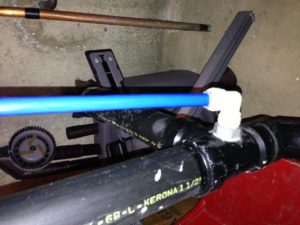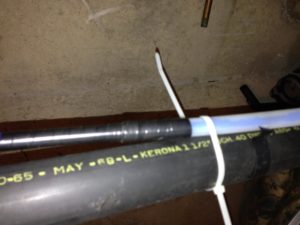One of the most important components of a proper softener installation is provision for safe drainage by avoiding a possible “cross connection”.
A cross connection is any point at which a water supply pipe or container is joined directly to a sewer pipe. It is at this point alone that it is even remotely possible for a water softening/conditioning system to introduce a hazard to a household. This can not happen if safe drainage is provided by using a sufficient air gap in the installation. NEVER MAKE A CROSS CONNECTION.
There are very simple reasons why a water treatment system must never be connected directly to a sewer pipe:
Consider a water treatment system installed with a direct drain connection to the sewer system, that is a cross connection. If, during the regeneration cycle there is a fire in the vicinity. What would happen if the firemen’s pumping equipment creates such a strong demand for water that suction occurs and it actually causes water to flow from the house back into the main line? Actually, if the suction were strong enough, some fluid from sewer pipes might be drawn back through the water treatment system and back out into the water supply lines. The danger is that sewage containing potentially pathogenic organisms could then be introduced into the water supply.
Obviously, the public health and the private welfare of your household must be at the uppermost consideration in the mind of the installer at all times. This is why the air gap rule must always be followed for drainage installations.
A softener drain line must not be connected directly to the waste system, but must be emptied into a laundry tray, floor drain, or properly trapped special outlet, preserving an air gap of at least two times the diameter of the drain line, but in no case less than 1-1/2″ above the top of the receptacle used. The greater of two and a half times the diameter of the equipment’s indirect drain or 1-1/2″ is the minimum air gap for whole house (point-of-entry) water treatment equipment. The greater of 2.5 times the equipment effective drain line diameter, or one inch, is allowed for point-of-use equipment. In addition, the end of the drain line should be secured so that there is no chance that it can become immersed in waste fluids.
Be sure to study and follow the equipment manufacturer’s installation instructions. They will specify drain line size. If the proper size is not provided, the unit may not be properly backwashed.
Type Of Drain Required
A laundry sink or any other sink can serve satisfactorily as an emptying place for the drain line, but it’s always best to discharge to the sewer whenever possible.
A trap installed in a waste line will also suffice, providing there is a proper air gap or vacuum breaker between the tap and the drain line from the softener.
A funnel arrangement may also be advantageously used in such an installation. A floor drain may also be used if it is out of the way of traffic. Rigid pipe should be used and positioned so that the minimum air gap cannot be reduced by moving the pipe. When the water treatment system is supplied with flexible drain line material, the drain must be tightly secured in the correct position to avoid deliberate or accidental movement.
Some units provide an overflow drain line for the regenerant container.
Such a line should be run to a floor drain. It must run by gravity feed to a lower drain.
Never EVER install a drain like this:
It gets worse (at the same installation):


Excellent articale, thank you Greg for the insight. Hope you don’t mind I have copies this article to my blog and gave you full credit. I think this is serious stuff that my readers need to know, in order to keep us all safe. You can see your article posted at http://www.trustedeblogs.com/indirect-drains-serious-stuff/
Not a problem at all, you write well.